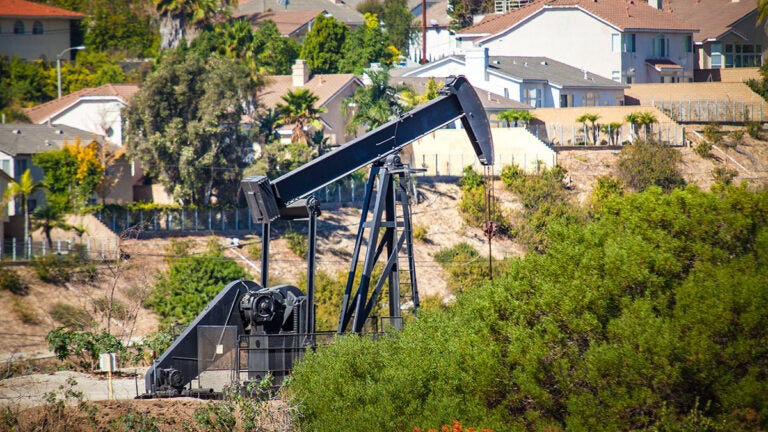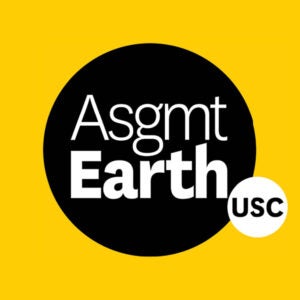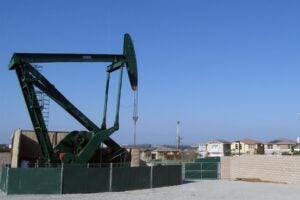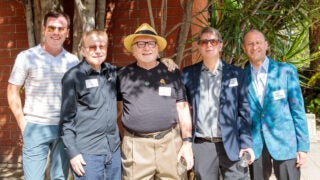
An oil pumpjack near homes in the Inglewood Oil Field. (Photo/Gary Kavanagh, iStock)
‘Sacrifice Zone: Los Angeles’ exposes the true cost of industrialization on public health
The interdisciplinary collaboration merges film and live theater to show visitors the impact of oil extraction firsthand.
A semi-trailer truck rumbles down the 710 Freeway, smoke billowing from its exhaust pipe. Its load: diesel fuel extracted from oil wells like the 1,100-acre Inglewood Oil Field in South Los Angeles.

Residents in South L.A., Inglewood and near the other oil wells and refineries dotting Los Angeles County know that where there is smoke, there is asthma, other unforeseen health issues and an unending cycle of social and political marginalization.
These communities’ stories of environmental injustice have informed Sacrifice Zone: Los Angeles, a new immersive, multimedia exhibition and performance opening on Saturday, Jan. 13, at the Natural Museum History of Los Angeles County.
“A sacrifice zone is an area or community facing environmental public health threats because it has been sacrificed to industry,” said production co-creator Paula Cizmar, professor at the USC School of Dramatic Arts and co-director of the school’s Institute for Theatre & Social Change.
Despite the ominous nature of the topic, Cizmar, along with co-creator Michael Bodie of the USC School of Cinematic Arts, said she hoped audiences would see the production as optimistic.
“The people in our play are not victims, but people who have decided to take action,” Cizmar said. “We hope that people not only learn about the sacrifice zones that are all over Los Angeles, but that they also want to take some action and realize there are people all around them who have said, ‘I am not going to put up with this and I am going to stand up for my neighborhood.’”
The interdisciplinary collaboration — made possible with a grant from USC Arts in Action — demonstrates the university’s focus on sustainability, one of USC President Carol Folt’s “moonshots.” Also dubbed “Assignment: Earth,” the initiative reflects the university’s emphasis on impactful research and education that may lead to new solutions for climate issues related to public health, innovation, policy and technology.
Immersive set gives visitors window into life in a sacrifice zone
The exhibit is a full-size house constructed inside the Otis Booth Pavilion at the Natural History Museum. The exhibit features videos and interactive projections that are a window into life in a sacrifice zone. Visitors will even be able to sit for a simulated drive in an 18-wheeler to learn about air quality, pollution and the makeup of the neighborhoods in the surrounding areas.
In the evenings, Sacrifice Zone: Los Angeles will feature a live performance that will convey L.A.’s history of environmental activism and feature effects sure to stimulate all five senses. A cast of six portrays an interactive household; audience members will be able to sit and stand beside the actors while they prepare to celebrate a family birthday. The audience will also be exposed to a “fume trail,” which will give them a sense of the malodors produced by the oil industry near these communities.
‘SACRIFICE ZONE: LOS ANGELES’
- When: 6:30-9 p.m. Jan. 13, 14, 19-21, 26 and 28.
- Where: Natural Museum History of Los Angeles County, in Exposition Park next to the USC University Park Campus.
- Tickets: Free, but reservations are required. RSVP online.
The play is the latest and final iteration of the Sacrifice Zone project, which began in 2019 and has been presented as an online performance in 2021 and as a multimedia installation experience on the USC University Park Campus in 2022 and 2023.
Bodie, an associate professor of the practice of cinematic arts at School of Cinematic Arts, said he and Cizmar saw a way to combine their formats — film and live theater — to amplify their message.
“We took a bus tour down in Long Beach in areas that have been clearly affected by the oil refineries in the area,” Bodie said. “Not only can you see the refinery — you can smell it and you can see it. It literally looms over the neighborhood. I realized our students could benefit from having a specialized experience through immersive theater, which we use to literally place you in a space that has some thought behind it.
“I really hope folks who come see and experience the show realize that there are problems out there, and that people have been working to improve these problems for a long time.”
Air pollution near L.A. freeways causes respiratory, cognitive health issues
Jill Johnston, an associate professor of population and public health sciences at the Keck School of Medicine of USC, served as a consultant for the project. For her field work, she regularly treks the neighborhoods that have been hardest hit by pollution and contamination, including Boyle Heights, where lead contamination from the Exide plant persists in the soil.
The health impacts of oil extraction are devastating, she said. The effects on respiratory health are similar to those generated by secondhand cigarette smoke, she said. USC researchers have also linked air pollution to increased risk for Alzheimer’s disease as well as dementia with car pollution in neighborhoods next to freeways.
“Research has shown that pollutants associated with oil and the extraction process are respiratory irritants and can exacerbate asthma symptoms,” said Johnston. “In our research with communities around the Las Cienegas Oil Field, we found that residents living closer to the well site had lower lung function compared to those living farther away. The wells in South L.A. are located just feet from where people live, work and go to school. The close proximity can increase the exposure to pollutants.”
The producers also reached out to community groups to hear from the people in the affected communities to incorporate their stories.
During the initial phases of the production, Cizmar and Bodie worked with Hugo Garcia, program director for People Not Pozos with Esperanza Community Housing. The program seeks environmental justice for the neighborhoods surrounding these industrialized, highly polluted areas of L.A. and other cities experiencing similar challenges worldwide. Garcia assisted a campaign that successfully prevented a decadeslong effort to extend the 710 Freeway into South Pasadena.
For Sacrifice Zone: Los Angeles, Garcia connected Bodie and Cizmar with South L.A. residents who spoke about how they had been affected by the pollution.

“One story that stuck out was that these plants create horrific odors, so the first thing most people would do is close the window,” Garcia said. “But during the summertime — and a lot of residents don’t have air conditioning — it was hard for them to close the windows because they didn’t get any circulation. It would give the kids such bad headaches that they couldn’t concentrate and do their homework. These kids were miserable.”
Cizmar, who is also the resident playwright for environmental justice at School of Dramatic Arts, said she hoped the installation captures the reality of life inside a sacrifice zone.
“We have video components that are actual stories from the people in the neighborhoods, footage of driving down the I-710 with information about air pollution,” Cizmar said. “All these things are available to attendees so you can dig into the real story of what’s going on in terms of data and statistics.”
At the live performance, Cizmar hopes that the exhibition brings home for everyone — including those residents whose stories informed the projects — what it is like to live in a sacrifice zone.
“I know there are going to be people from the community who will say, ‘That’s me. That’s my life.’”
Featured Experts
Paula Cizmar
Expert in documentary theatre, social justice issues and the arts, theatre as a force for human rights, gender and equity issues in theatre, women in theatre, environmental issues and the arts, water and drought as portrayed in theatre and media, Owens Valley as portrayed in media, climate change as portrayed in theatre and theatre of the American West
Jill Johnston
Expert in environmental justice, environmental health disparities, toxic metals, lead, Exide, vapor intrusion, PCE, TCE, hazardous waste and wastewater, oil and gas pollution, public health, industrial agriculture, hog farms and climate justice



